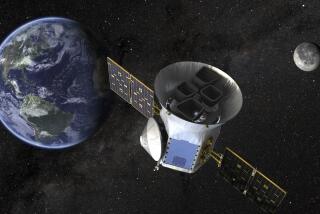A couple dozen new planets, but none like ours
- Share via
HONOLULU — An international team of astronomers on Monday announced the discovery of 28 planets outside the solar system, the greatest single haul since the first so-called exoplanet was found 12 years ago.
Still eluding the planet hunters, however, is the much-longed-for Earth replica, a planet like ours that could nourish some kind of life, allowing humans to feel a little less lonely in the cosmos.
The new batch of planets brings to 236 the number found circling other stars, said UC Berkeley astronomer Jason Wright. Among the discoveries are four multiple-planet systems.
Of the stars known to have planets, almost a third have more than one, Wright said at a news conference at the Honolulu Convention Center, where the American Astronomical Society is holding its semiannual meeting.
The new results show that “the frequency of planetary systems is immensely larger than anyone would have guessed,” said Alan Boss of the Carnegie Institute in Washington, D.C.
Even more surprising, Boss said, is that “every sort of star we’ve looked at has a planet.”
That includes pulsars, the bizarre objects that shoot out bursts of energy at regular intervals.
Much of the new research focused on red dwarfs -- stars that are smaller and dimmer than the sun but that burn at a steady rate for billions of years, allowing life in the so-called habitable zone to flourish for longer periods.
The sun burns brighter and will burn out faster, meaning life on Earth will have a shorter span than life would have on a planet around a red dwarf.
So far, only one planet has been found orbiting a red dwarf in a zone where life might exist. About six times larger than Earth, the planet orbits the star Gliese 581. Its existence was announced a month ago by a European group of planet hunters.
That planet orbits so close to its star that it could be tidally locked, the American astronomers said. That means it would present only one face to the star, the way the moon presents one face to Earth.
On that planet, the astronomers said, temperatures on the bright side would be far too hot for life. But on its dark side, temperatures could range between 50 and 97 degrees Fahrenheit.
The team also likened another recently discovered exoplanet to Neptune. The planet orbits a red dwarf called Gliese 436, about 30 light-years from Earth.
Geoff Marcy, head of the Berkeley team, said an analysis of its density showed “it must be 50% rock and 50% water.”
“So this planet has the interior structure of a hybrid super-Earth/Neptune, with a rocky core surrounded by a significant amount of water compressed into solid form at high pressures and temperatures,” Marcy said.
The European team called it a “hot ice world.” The Americans said they were unsure what hot water compressed into a solid would be like.
Though much of the planet hunting has so far focused on smaller stars, Berkeley astronomer John A. Johnson said aging giant stars might harbor even more planets than their smaller siblings. Five of the 28 new planets circle these “retired A stars,” he said.
Johnson also said the planets around bigger stars appeared to be farther from their hosts than those around smaller stars.
The California and Carnegie astronomers used telescopes at the University of California’s Lick Observatory and the W.M. Keck Observatory in Hawaii for their research.
The astronomers said the detection rate for exoplanets was rising as observers got more telescope time and as their techniques improved.
Astronomers said they hoped the new results would put pressure on NASA, and Congress, to put more money into the search for extraterrestrial worlds.
NASA has several planet-finding missions on the drawing board, including a space-based instrument that could directly image planets in systems light-years away by blotting out the light of their stars.
*






